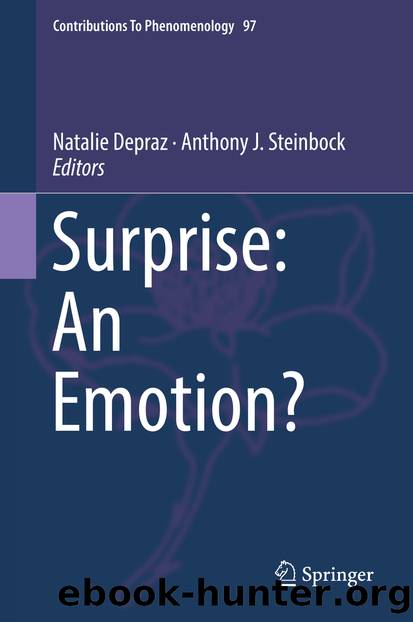Surprise: An Emotion? by Unknown

Author:Unknown
Language: eng
Format: epub
ISBN: 9783319986579
Publisher: Springer International Publishing
5 The Challenge of Being True to the Truths of Affective Experience
In accordance with Darwinâs perspicuous observation about infancy cited in the context of the second perspective, we would do well to begin at the beginning, that is, with ontogeny, if we are to be true to the truths of affective experience. The task is challenging because our adult vantage point is so seductive. We forget that we all came into a totally unfamiliar world; indeed in the beginning, we entered like aliens on a foreign planet. We were not, however, totally foreign to ourselves, for we had spent some time moving ourselves. Starting around the 11th of our 42 weeks in the womb, we opened and closed our lips, we turned our head, we moved our hands and feet. Later, approximately halfway through those 42 weeks, our sucking and grasping reflexes begin to develop; we kicked our legs kick and waved our arms, and might have put a thumb in our mouth (Furuhjelm et al. 1977, pp. 95, 124). In short, our prenatal life was a life of developing movement. Moreover sound was not foreign to us. As medical researchers have noted, âThe uterus is no silent, peaceful environment. The womanâs pulse is constantly pounding; the placenta surges and murmurs; at times the woman moves abruptly, or speaks loudlyâ (ibid., p. 124). In effect, when we come into earthly life, we are like aliens on a foreign planet, but we are not dumb to touch, movement, and sound. Indeed, we are not awaiting consciousness as Daniel Dennett declared when he wrote, â[consciousness] arises when there is work for it to do, and the preeminent work of consciousness is dependent on sophisticated language-using activitiesâ (Dennett 1983, p. 384).
Being true to the truths of affective experience requires attention not just to infancy but to basic animate realities such as the startle reflex, a fundamental reflex that psychologists Carney Landis and William Hunt studied in experimental fine detail across a range of subjects, including pathological and nonhuman subjects. The startle reflex is an affectively-charged movement pattern and clearly experienced as such, both when we ourselves are startled and when we see others startled. Landis and Hunt describe the movement pattern of the startle reflex âto be a general bodily flexion ⦠which resembles a protective contraction or âshrinkingâ of the individualâ (Landis and Hunt 1939, p. 23). They detail the pattern specifically as follows: âblinking of the eyes, head movement forward, a characteristic facial expression, raising and drawing forward of the shoulders, abduction of the upper arms, bending of the elbows, pronation of the lower arms, flexion of the fingers, forward movement of the trunk, contraction of the abdomen, and bending of the kneesâ (ibid., p. 21). The pattern is clearly complex. Landis and Hunt note too the responsive character of the pattern, namely, that â[t]he response is very rapid and follows sudden, intense stimulation,â and that the âbasic reaction [is] not amenable to voluntary control, [and] is universalâ (ibid.). Finally, they
Download
This site does not store any files on its server. We only index and link to content provided by other sites. Please contact the content providers to delete copyright contents if any and email us, we'll remove relevant links or contents immediately.
They Both Die at the End by Adam Silvera(9724)
Thirteen Reasons Why by Jay Asher(8801)
The Space Between by Michelle L. Teichman(6866)
Suicide Notes by Michael Thomas Ford(4765)
Tuesdays with Morrie by Mitch Albom(4696)
Suicide: A Study in Sociology by Emile Durkheim(2975)
The Checklist Manifesto by Atul Gawande(2784)
Tuesdays With Morrie by Mitch Albom(2697)
In the Woods by Tana French(2535)
Bossypants by Tina Fey(2474)
Robin by Dave Itzkoff(2387)
Olive Kitteridge by Elizabeth Strout(2315)
No Ashes in the Fire by Darnell L Moore(2298)
Reservoir 13 by Jon McGregor(2244)
End of Days by Sylvia Browne(2120)
All Things New by John Eldredge(2106)
Bus on Jaffa Road by Mike Kelly(2104)
Scar Tissue by Anthony Kiedis(2094)
No Time to Say Goodbye(2063)
